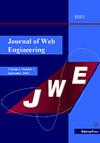A Keyword-Based IP Tracking Method for Illegal Web Content Distribution Using Port Scanning on HTTP and HTTPS
IF 1
4区 计算机科学
Q4 COMPUTER SCIENCE, SOFTWARE ENGINEERING
引用次数: 0
Abstract
The rapid expansion of online content distribution has led to a significant increase in copyright infringement, where unauthorized works are illegally shared through various web-based platforms. To fundamentally block these copyright-infringing websites, it is essential to accurately identify the IP address or physical location of the original server. However, most illegal content distribution sites utilize advanced security mechanisms, such as DNS resolvers, reverse proxies, and anonymization techniques, to conceal their true IP addresses, making direct tracking increasingly difficult. These evasive tactics allow illegal sites to continue operating while avoiding enforcement measures. To address this challenge, this paper proposes a keyword-based IP tracking method for identifying illegal web content distribution sites by leveraging port scanning on HTTP and HTTPS (ports 80 and 443). The proposed approach systematically detects and analyzes servers that provide unauthorized content by scanning network ports commonly used for web services. By correlating detected IP addresses with keyword-based filtering techniques, this method enables efficient tracking of illegal sites that actively hide their original server's IP address. Through experimental validation, the proposed method successfully pinpoints the IP addresses of illegal content distribution servers, even when they employ obfuscation techniques to mask their identity. This study contributes to enhancing copyright protection by introducing a web-based detection approach that integrates network security techniques, web engineering principles, and automated keyword analysis. Furthermore, the findings provide a practical solution for law enforcement agencies, copyright holders, and regulatory bodies to combat illegal web content distribution more effectively.基于HTTP和HTTPS端口扫描的基于关键字的非法Web内容分发IP跟踪方法
网络内容传播的迅速扩张导致了版权侵权的显著增加,未经授权的作品通过各种网络平台被非法分享。要从根本上屏蔽这些侵犯版权的网站,必须准确识别原始服务器的IP地址或物理位置。然而,大多数非法内容分发站点利用高级安全机制(如DNS解析器、反向代理和匿名化技术)来隐藏其真实IP地址,这使得直接跟踪变得越来越困难。这些规避策略使非法网站得以继续运营,同时避免了执法措施。为了应对这一挑战,本文提出了一种基于关键字的IP跟踪方法,通过利用HTTP和HTTPS(端口80和443)上的端口扫描来识别非法web内容分发站点。该方法通过扫描web服务常用的网口,系统地检测和分析提供未经授权内容的服务器。通过将检测到的IP地址与基于关键字的过滤技术相关联,这种方法可以有效地跟踪主动隐藏其原始服务器IP地址的非法网站。通过实验验证,所提出的方法成功地确定了非法内容分发服务器的IP地址,即使他们使用混淆技术来掩盖他们的身份。本研究通过引入一种基于网络的检测方法,将网络安全技术、网络工程原理和自动关键字分析相结合,有助于加强版权保护。此外,调查结果为执法机构、版权持有人和监管机构提供了切实可行的解决方案,以更有效地打击非法网络内容的传播。
本文章由计算机程序翻译,如有差异,请以英文原文为准。
求助全文
约1分钟内获得全文
求助全文
来源期刊

Journal of Web Engineering
工程技术-计算机:理论方法
CiteScore
1.80
自引率
12.50%
发文量
62
审稿时长
9 months
期刊介绍:
The World Wide Web and its associated technologies have become a major implementation and delivery platform for a large variety of applications, ranging from simple institutional information Web sites to sophisticated supply-chain management systems, financial applications, e-government, distance learning, and entertainment, among others. Such applications, in addition to their intrinsic functionality, also exhibit the more complex behavior of distributed applications.
 求助内容:
求助内容: 应助结果提醒方式:
应助结果提醒方式:


